
FAIR is a non-profit organization dedicated to providing well-documented answers to criticisms of the doctrine, practice, and history of The Church of Jesus Christ of Latter-day Saints.
The manner of the translation is described repeatedly, for example, in the Church's official magazine for English-speaking adults, the Ensign. Richard Lloyd Anderson discussed the "stone in the hat" matter in 1977,[1] and Elder Russell M. Nelson quoted David Whitmer's account to new mission presidents in 1992.[2]
The details of the translation are not certain, and the witnesses do not all agree in every particular. However, Joseph's seer stone in the hat was also discussed by, among others: B.H. Roberts in his New Witnesses for God (1895)[3] and returns somewhat to the matter in Comprehensive History of the Church (1912).[4] Other Church sources to discuss this include The Improvement Era (1939),[5] BYU Studies (1984, 1990)[6] the Journal of Book of Mormon Studies (1993),[7] and the FARMS Review (1994).[8] LDS authors Joseph Fielding McConkie and Craig J. Ostler also mentioned the matter in 2000.[9] Elder Bruce R. McConkie talked about the seer stone in his second edition of Mormon Doctrine (1966), clearly distinguishing it from the Urim and Thummim, loosely implying that it was involved in the translation of the Book of Mormon, and quoting President Joseph Fielding Smith who said that "[t]his seer stone is now in the possession of the Church."[10]
In fact, historical evidence shows that in addition to the two seer stones known as “interpreters,” Joseph Smith used at least one other seer stone in translating the Book of Mormon, often placing it into a hat in order to block out light. According to Joseph’s contemporaries, he did this in order to better view the words on the stone.
—Richard E. Turley Jr., Robin S. Jensen and Mark Ashurst-McGee, "Joseph the Seer," Ensign (October 2015)
The stone pictured here has long been associated with Joseph Smith and the Book of Mormon translation. The stone Joseph Smith used in the Book of Mormon translation effort was often referred to as a chocolate-colored stone with an oval shape. This stone passed from Joseph Smith to Oliver Cowdery and then to the Church through Brigham Young and others.
—Richard E. Turley Jr., Robin S. Jensen and Mark Ashurst-McGee, "Joseph the Seer," Ensign (October 2015)
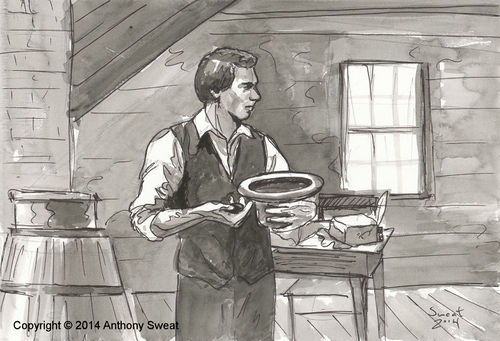
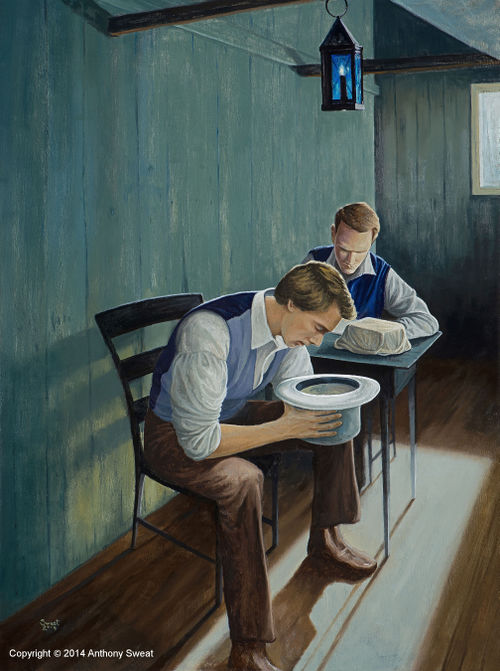
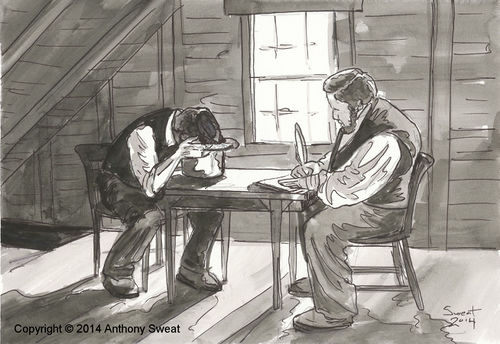
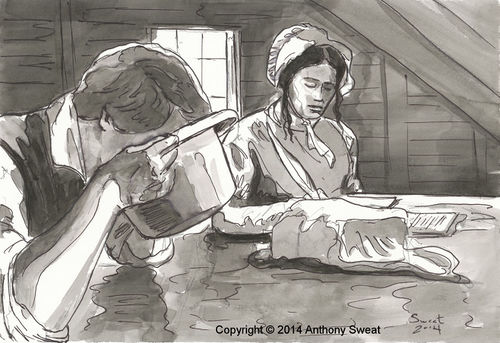
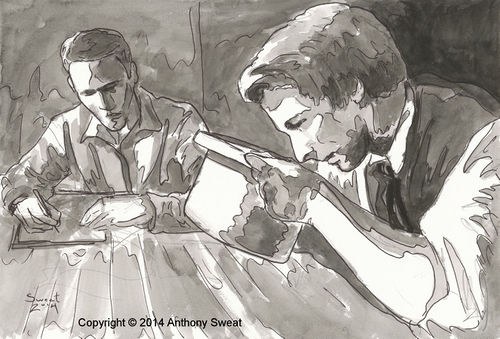
The Urim and Thummim was “an instrument prepared of God to assist man in obtaining revelation from the Lord and in translating languages” (Bible Dictionary, “Urim and Thummim”). Joseph Smith used the Urim and Thummim to aid in the translation of the Book of Mormon. In addition to the Urim and Thummim, the Prophet used a seer stone in the translation process.
Elder Neal A. Maxwell of the Quorum of the Twelve Apostles said the following about the translation process and Joseph Smith’s use of the Urim and Thummim and the seer stone:
“The Prophet Joseph alone knew the full process, and he was deliberately reluctant to describe details. We take passing notice of the words of David Whitmer, Joseph Knight, and Martin Harris, who were observers, not translators. David Whitmer indicated that as the Prophet used the divine instrumentalities provided to help him, ‘the hieroglyphics would appear, and also the translation in the English language … in bright luminous letters.’ Then Joseph would read the words to Oliver (quoted in James H. Hart, “About the Book of Mormon,” Deseret Evening News, 25 Mar. 1884, 2). Martin Harris related of the seer stone: ‘Sentences would appear and were read by the Prophet and written by Martin’ (quoted in Edward Stevenson, “One of the Three Witnesses: Incidents in the Life of Martin Harris,” Latter-day Saints’ Millennial Star, 6 Feb. 1882, 86–87). Joseph Knight made similar observations (see Dean Jessee, “Joseph Knight’s Recollection of Early Mormon History,” BYU Studies 17 [Autumn 1976]: 35).
"Lesson 10: Joseph Smith—History 1:55–65," Doctrine and Covenants and Church History Seminary Teacher Manual, 2013 (available online at LDS.org)
Two accounts of the translation process, including the use of a seer stone, have been written by members of the Quorum of the Twelve Apostles and published in Church magazines. Historians have also written about the seer stone in Church publications, both in the Ensign and in The Joseph Smith Papers. (See Neal A. Maxwell, “‘By the Gift and Power of God,’” Ensign, Jan. 1997, 36–41; Russell M. Nelson, “A Treasured Testament,” Ensign, July 1993, 61–63; Richard Lloyd Anderson, “‘By the Gift and Power of God,’” Ensign, Sept. 1977, 78–85; and Documents, Volume 1: July 1828–June 1831, xxix–xxxii.)
—"Book of Mormon Translation," Gospel Topics on lds.org off-site
Gerrit Dirkmaat (Church History Department - January 2013 Ensign):
Those who believed that Joseph Smith’s revelations contained the voice of the Lord speaking to them also accepted the miraculous ways in which the revelations were received. Some of the Prophet Joseph’s earliest revelations came through the same means by which he translated the Book of Mormon from the gold plates. In the stone box containing the gold plates, Joseph found what Book of Mormon prophets referred to as “interpreters,” or a “stone, which shall shine forth in darkness unto light” (Alma 37:23–24). He described the instrument as “spectacles” and referred to it using an Old Testament term, Urim and Thummim (see Exodus 28:30).2
He also sometimes applied the term to other stones he possessed, called “seer stones” because they aided him in receiving revelations as a seer. The Prophet received some early revelations through the use of these seer stones. For example, shortly after Oliver Cowdery came to serve as a scribe for Joseph Smith as he translated the plates, Oliver and Joseph debated the meaning of a biblical passage and sought an answer through revelation. Joseph explained: “A difference of opinion arising between us about the account of John the Apostle … whether he died, or whether he continued; we mutually agreed to settle it by the Urim and Thummim.”3 In response, Joseph Smith received the revelation now known as section 7 of the Doctrine and Covenants, which informed them that Jesus had told the Apostle John, “Thou shalt tarry until I come in my glory” (D&C 7:3).
Records indicate that soon after the founding of the Church in 1830, the Prophet stopped using the seer stones as a regular means of receiving revelations. Instead, he dictated the revelations after inquiring of the Lord without employing an external instrument. One of his scribes explained that process: “The scribe seats himself at a desk or table, with pen, ink, and paper. The subject of inquiry being understood, the Prophet and Revelator inquires of God. He spiritually sees, hears, and feels, and then speaks as he is moved upon by the Holy Ghost.”
Gerrit Dirkmaat (Church History Department), "Great and Marvelous Are the Revelations of God," Ensign, January 2013. (emphasis added) off-site
In 2005, Opening the Heavens was published jointly by the Joseph Fielding Smith Institute for Latter-day Saint History and Deseret Book. As part of this book, at least twenty-nine references to the stone (often with the hat) are included, from both friendly and hostile sources:
"Martin Harris related of the seer stone: 'Sentences would appear and were read by the Prophet and written by Martin'"
—Neal A. Maxwell, “‘By the Gift and Power of God’,” Ensign, January 1997, 36 (emphasis added) off-site
"David Whitmer wrote: ' Joseph Smith would put the seer stone into a hat, and put his face in the hat, drawing it closely around his face to exclude the light; and in the darkness the spiritual light would shine.'"
—Russell M. Nelson, “A Treasured Testament,” Ensign, Jul 1993, 61. (emphasis added) off-site
"Jacob censured the "stiffnecked" Jews for "looking beyond the mark" (Jacob 4:14). We are looking beyond the mark today, for example, if we are more interested in the physical dimensions of the cross than in what Jesus achieved thereon; or when we neglect Alma's words on faith because we are too fascinated by the light-shielding hat reportedly used by Joseph Smith during some of the translating of the Book of Mormon. To neglect substance while focusing on process is another form of unsubmissively looking beyond the mark."
—Neal A. Maxwell, Not My Will, But Thine (Salt Lake City, Utah: Bookcraft, 1988), 26.
The scriptures indicate that translation involved sight, power, transcription of the characters, the Urim and Thummim or a seerstone, study, and prayer.
After returning from a trip to Palmyra to settle his affairs, Martin began to transcribe. From April 12 to June 14, Joseph translated while Martin wrote, with only a curtain between them. On occasion they took breaks from the arduous task, sometimes going to the river and throwing stones. Once Martin found a rock closely resembling the seerstone Joseph sometimes used in place of the interpreters and substituted it without the Prophet’s knowledge. When the translation resumed, Joseph paused for a long time and then exclaimed, “Martin, what is the matter, all is as dark as Egypt.” Martin then confessed that he wished to “stop the mouths of fools” who told him that the Prophet memorized sentences and merely repeated them." —Kenneth W. Godfrey, "A New Prophet and a New Scripture: The Coming Forth of the Book of Mormon," Ensign (Jan 1988).
"There he gave his most detailed view of 'the manner in which the Book of Mormon was translated': “Joseph Smith would put the seer stone into a hat and put his face in the hat, drawing it closely around his face to exclude the light."
—Richard Lloyd Anderson, "‘By the Gift and Power of God’," Ensign (Sep 1977): 79, emphasis added. off-site
"To help him with the translation, Joseph found with the gold plates “a curious instrument which the ancients called Urim and Thummim, which consisted of two transparent stones set in a rim of a bow fastened to a breastplate.” Joseph also used an egg-shaped, brown rock for translating called a seer stone."
—“A Peaceful Heart,” Friend, Sep 1974, 7 off-site
Notes

FAIR is a non-profit organization dedicated to providing well-documented answers to criticisms of the doctrine, practice, and history of The Church of Jesus Christ of Latter-day Saints.
We are a volunteer organization. We invite you to give back.
Donate Now